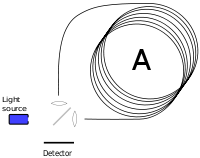
Photo from wikipedia
In order to meet in many aspects contradictory requirements to gyroscopes used in space applications, this paper proposes to use the multimode Coriolis vibratory gyroscope, which operates in a new… Click to show full abstract
In order to meet in many aspects contradictory requirements to gyroscopes used in space applications, this paper proposes to use the multimode Coriolis vibratory gyroscope, which operates in a new differential mode in addition to well-known rate and rate-integrating modes. The differential mode of operation can provide high resistance to external disturbances acting on the gyroscope under operating in launch, docking, and landing regimes of spacecraft. The differential mode of operation differs from the other two known modes by the presence of two, X and Y, measurement channels. Each of the channel measures angle rate with opposite sign. This mode of operation can be implemented by the disposition of standing wave pattern between the drive and sense electrodes. The paper presents promising capabilities of the differential mode of operation to self-compensate for external disturbances. The condition for the standing wave angle disposition that provides maximum compensation for the disturbances is proposed. Numerical and graphical test results on the determination of shock suppression coefficient, vibration sensitivity reduction coefficient, and also reduction of sensitivity to constant and variable magnetic fields are presented.
Journal Title: International Journal of Aerospace Engineering
Year Published: 2019
Link to full text (if available)
Share on Social Media: Sign Up to like & get
recommendations!